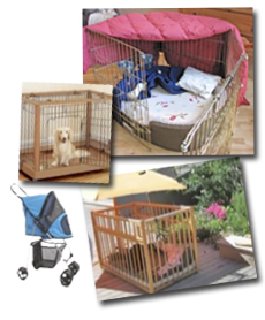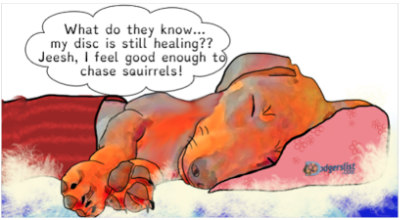Kyla, when they are starting to feel good, it can be more of a challenge to keep them calm.
CALMERS
Using any oral calmer in combination with a Pheromone diffuser seems to work best. It takes several days for these to start working - it isn't immediate but they are a much better option if you can avoid heavy duty prescription sedatives (ACE, alprazolam or traZODone). Of course always keep your vet in the loop on all things you give your dog.
Place a
DAP pheromone diffusor at floor level where the recovery suite is:
--DOG Adaptil (DAP) wall plug in diffuser 48ml
www.adaptil.com/Use diffusor with one
oral calmer from below:
1) ANXITANE® S chewable tabs contain 50 mg L-Theanine, an amino acid that acts neurologically to help keep dogs calm, relaxed
www.virbac2) Composure Soft Chews are colostrum based like calming mother's milk and contain 21 mg of L-Theanine.
www.vetriscience.com/composure-soft-dogs-MD-LD.php Consider some of these ideas to help Kaiser relax in his recovery suite:
-- the whining problem: the stroller can be wheeled from room to room as you go about your activities. Pet strollers, however, should only be used when you are directly supervising. More details on strollers:
dodgerslist.com/2020/05/17/pet-stroller-conservatve-treatment/ Don't need anything fancy or full featured as stroller will be only used in the house or on the deck where there is smooth rolling.
-- Put a garment you have been wearing and have not washed in the crate.
-- Thundershirt® to calm anxieties similar concept as swaddling an infant to calm.
thundershirt.com/products/thundershirt-for-dogs-- Spend some time wearing your dog out with mental stimulation with tricks that do not make the back move such a nose touch a paw or a food bowl. Of course the training takes place inside the crate.
www.clickertraining.com/15tips-- Teaching self-calming exercises can also help your dog to relax more. You can make something as simple as eye contact a very rewarding behavior that also acts as a way for your dog to “ask permission” when he wants something. When dogs have a focus and an understanding about how to behave to get what they want, they are much calmer overall. To do this, each time your dog looks at you, say, something like, “Yes!” or use a clicker to mark the second he looks at you, and then give your dog a high-value food reward. [NOTE: for crate resting dogs, shift your body a bit] .... wait for your dog to look up at you again, say, “Yes,” and reward again. Do this exercise 10 or so times and then say, “All done,” and put the treats away. Come back later and do it again until you can see that your dog is really starting to make automatic eye contact in hopes you will say, “Yes,” again and give him his reward.
[NOTE: treats should be subtracted from the normal daily kibble ration so as not to gain weight during crate rest. To dogs the size of the treat matters not. ]
wholedogtraining.com/images/stories/Are_all_dogs_trainable.pdf-- Provide a lick mat in the recovery suite. Freeze with some soaked and mushed up kibble, a slight slather of canned dog food or other lo-cal smear, as a very tiny treat but one that will take a lot of time to consume. Use as long as your dog is not exceeding the requirement of little neck/back movement during the recovery rest period
www.amazon.com/s?k=lick+mat+for+dogs&hvadid=78202818358910&hvbmt=be&hvdev=c&hvqmt=e&tag=mh0b-20&ref=pd_sl_3b30nygjvi_e-- At night, try placing the crate on a sturdy bedside table to sleep next to you.
-- During the day try the coffee table or the dinning room table so there will be a view out a window and a better perspective on what is going on in the house from a high.
-- Make the crate or ex-pen more cozy by draping a blanket over part of the top.
dodgerslist.com/wp-content/uploads/2020/05/blanketTOP150.jpg **
- Most dogs need some 16-18 hours of sleep per day, people sleep 8-9 hours day. What are they doing in the crate? Laying around and sleeping! Don't give into the temptation to start a treat routine to combat non-existent boredom. Adding a bunch of treats as entertainment contributes to weight gain which isn't a good thing. What you CAN do is soak his kibble in broth and freeze each of his normal kibble meals into a Kong so he has a job... working for his food.
Be aware you might be inadvertently training for unwanted behavior. To dogs rewards are: food, looking at them, talking to them, eye contact, approaching the crate, petting. So anytime you see unwanted behavior try speaking in your dog's language so he understands to calm down. Turn your body sideways, avoid eye contact until he calms and settles down. Preferable is to start teaching what you do want before there is too much practice in doing the unwanted behavior. Anytime your dog is sitting or lying down quietly, give a reward of a calm loving "good sit/lie." Soon your dog will see they get rewards by quietly sitting, etc.
Hope one of these ideas will help you out.






